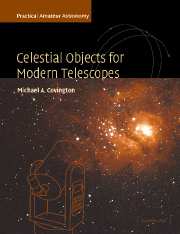Book contents
- Frontmatter
- Contents
- Preface
- Part I Amateur astronomy
- 1 Using this book effectively
- 2 Observing sites and conditions
- 3 The Moon, the Sun, and eclipses
- 4 The planets
- 5 Comets, asteroids (minor planets), and artificial satellites
- 6 Constellations
- 7 Stars – identification, nomenclature, and maps
- 8 Stars – physical properties
- 9 Double and multiple stars
- 10 Variable stars
- 11 Clusters, nebulae, and galaxies
- Part II 200 interesting stars and deep-sky objects
- Appendices
- Index
2 - Observing sites and conditions
Published online by Cambridge University Press: 22 September 2009
- Frontmatter
- Contents
- Preface
- Part I Amateur astronomy
- 1 Using this book effectively
- 2 Observing sites and conditions
- 3 The Moon, the Sun, and eclipses
- 4 The planets
- 5 Comets, asteroids (minor planets), and artificial satellites
- 6 Constellations
- 7 Stars – identification, nomenclature, and maps
- 8 Stars – physical properties
- 9 Double and multiple stars
- 10 Variable stars
- 11 Clusters, nebulae, and galaxies
- Part II 200 interesting stars and deep-sky objects
- Appendices
- Index
Summary
Darkness and night vision
Dark adaptation
The human eye takes time to adapt to dim light. Although the pupil opens up almost immediately, that's not the whole story. Dark adaptation involves the release of the light-sensitive chemical rhodopsin (visual purple) in the retina. For astronomy, useful dark adaptation takes about ten minutes, and substantial improvement continues for half an hour or more.
The central part of the retina does not function in dim light; faint objects disappear if you look straight at them. Experienced observers use averted vision, which means that they view the faintest stars, nebulae, and galaxies by looking slightly to one side of the object rather than directly at it.
Visual perception of faint objects is not continuous. A star near the limit of vision may be evident only a third of the time; it will seem to pop into and out of view. As long as you keep seeing it in the same place, you can be sure that it's real even though you can't see it continuously.
Even a small amount of bright light prevents complete dark adaptation; that's why a distant streetlight or even an illuminated doorbell button can be so annoying. Red light does not do this as much as other colors, which is why astronomers use red flashlights. The light must be red (or orange), not just reddish; what matters is the absence of blue wavelengths, not the red color.
- Type
- Chapter
- Information
- Celestial Objects for Modern TelescopesPractical Amateur Astronomy Volume 2, pp. 6 - 22Publisher: Cambridge University PressPrint publication year: 2002



